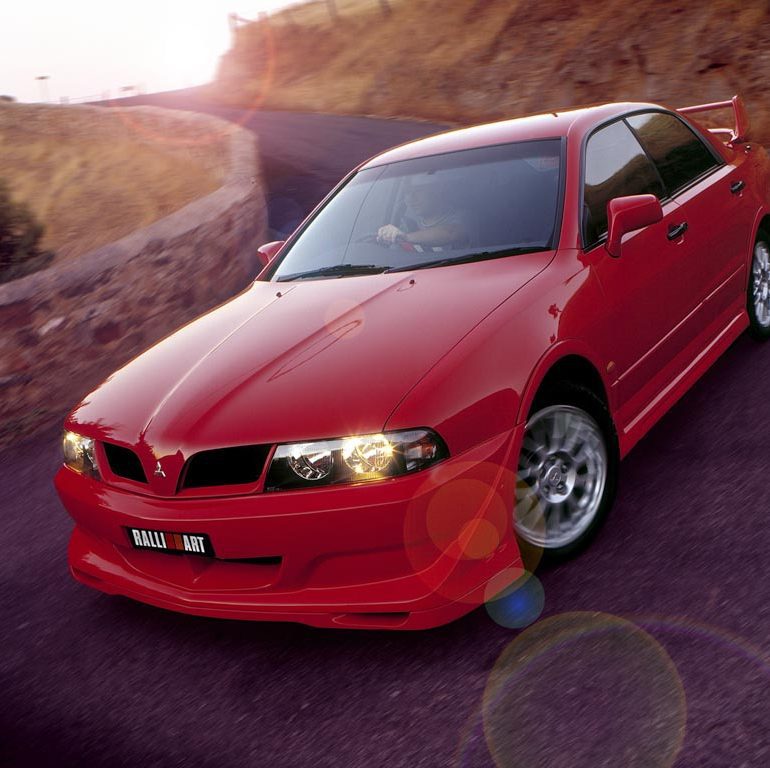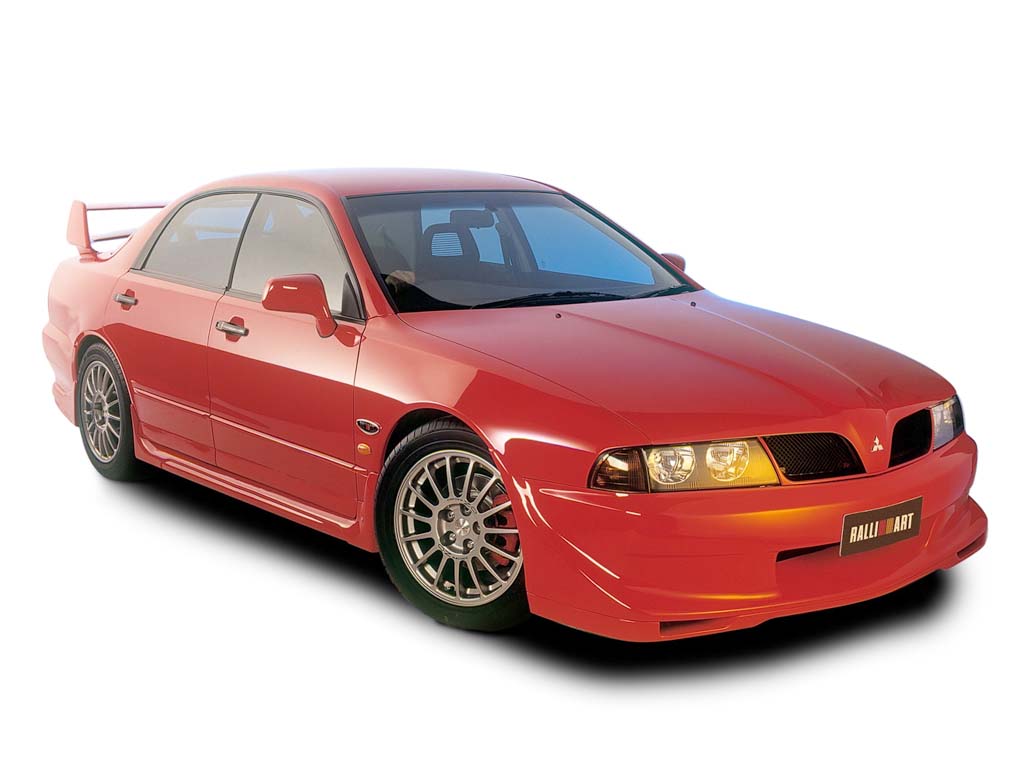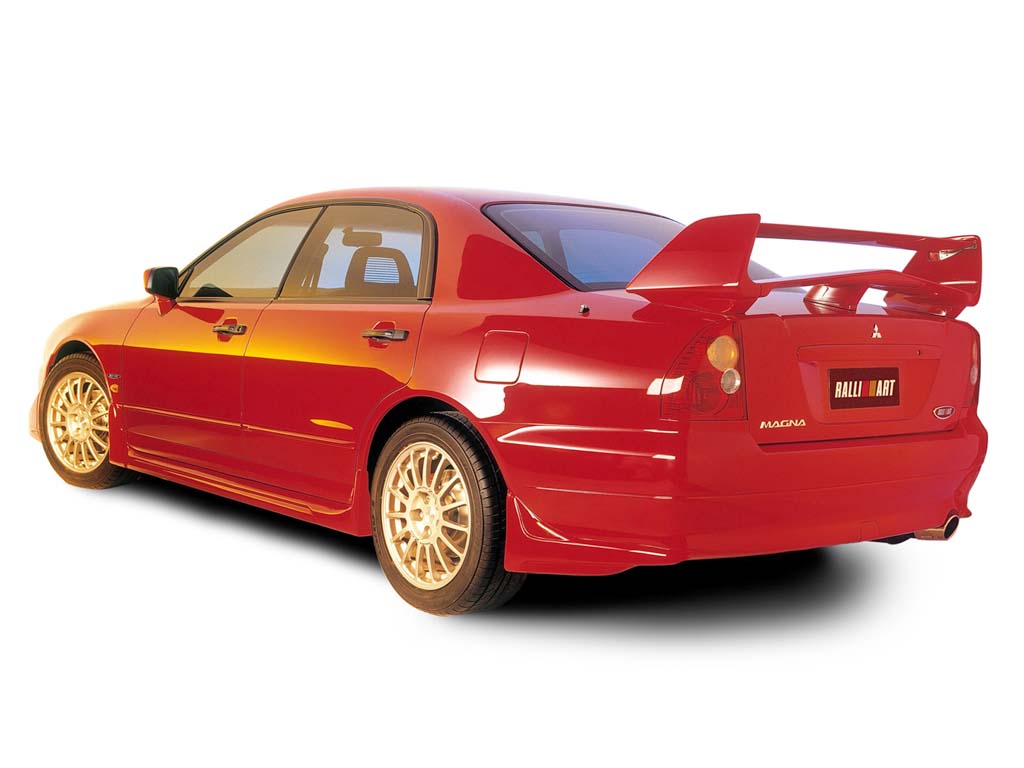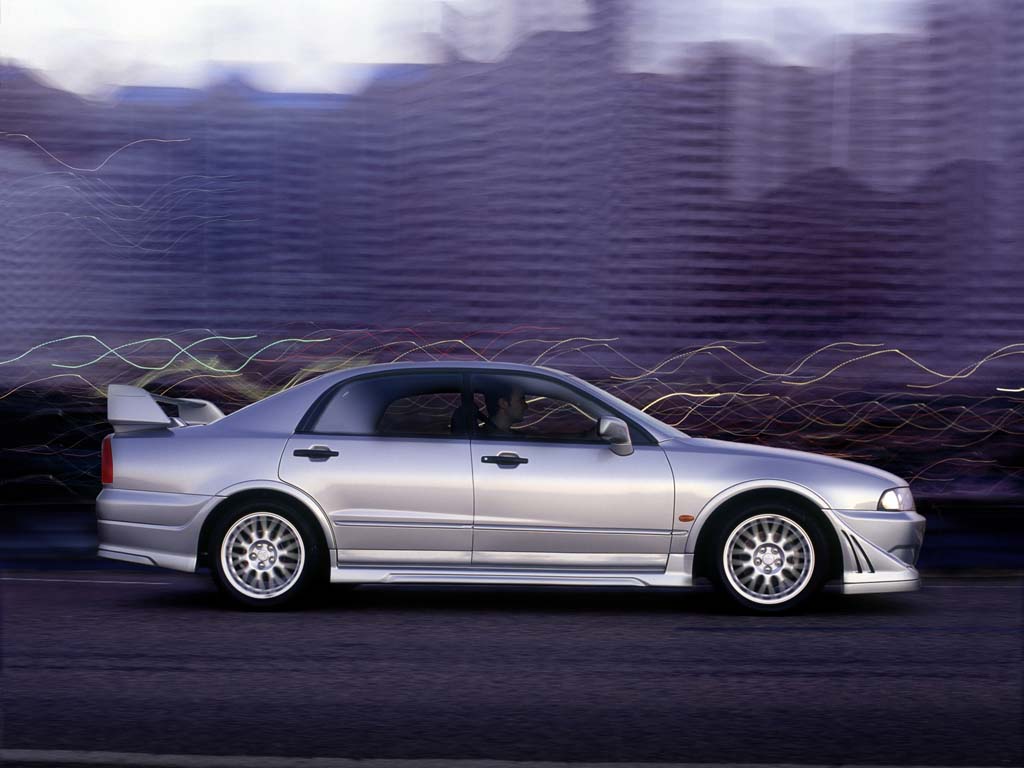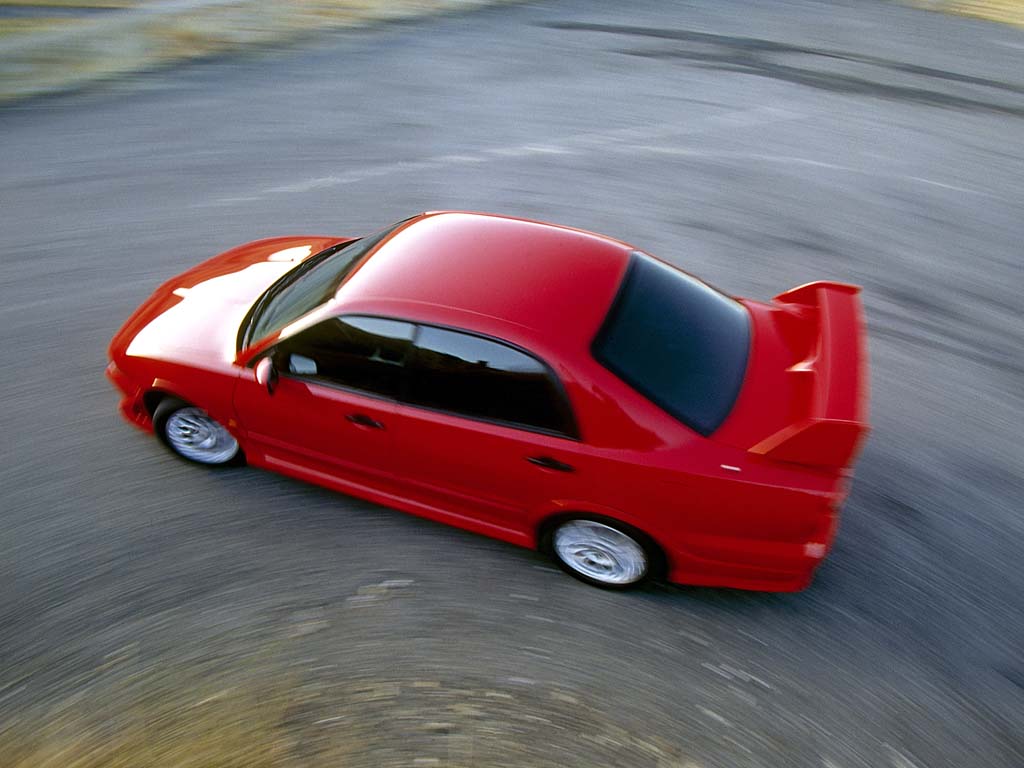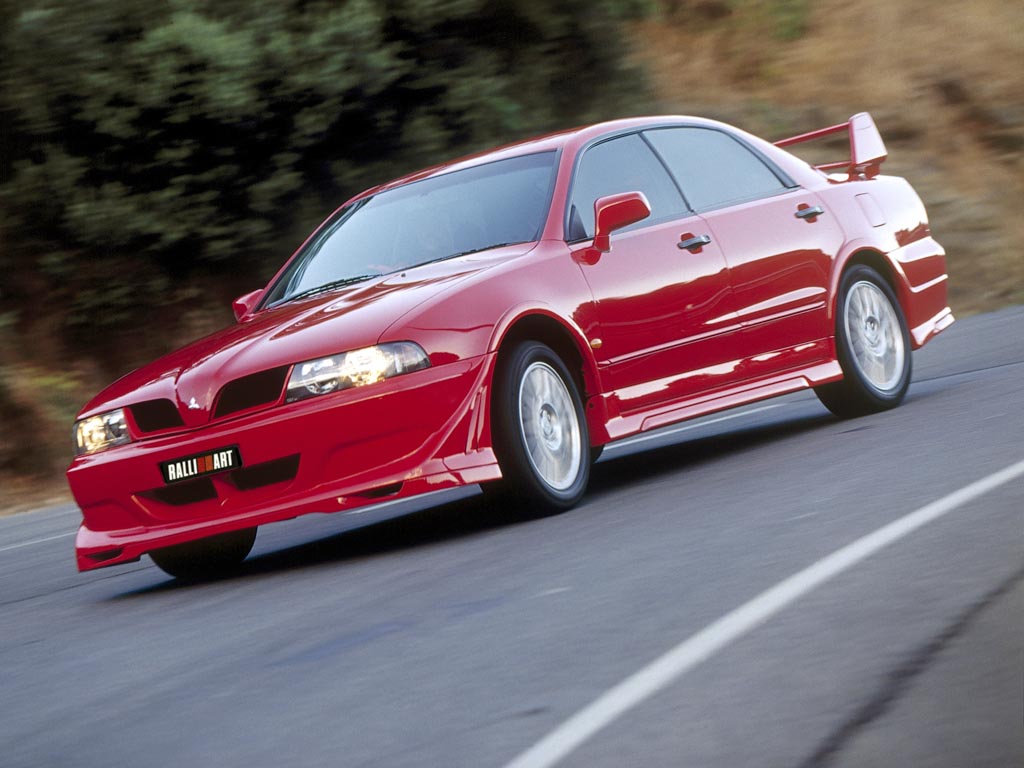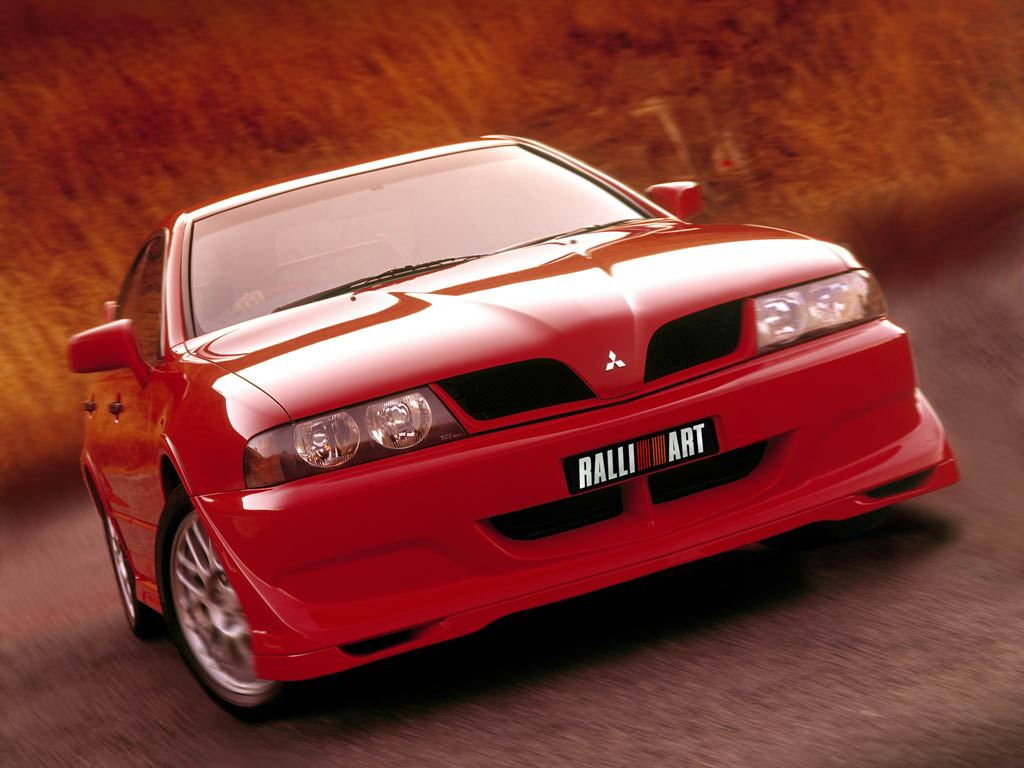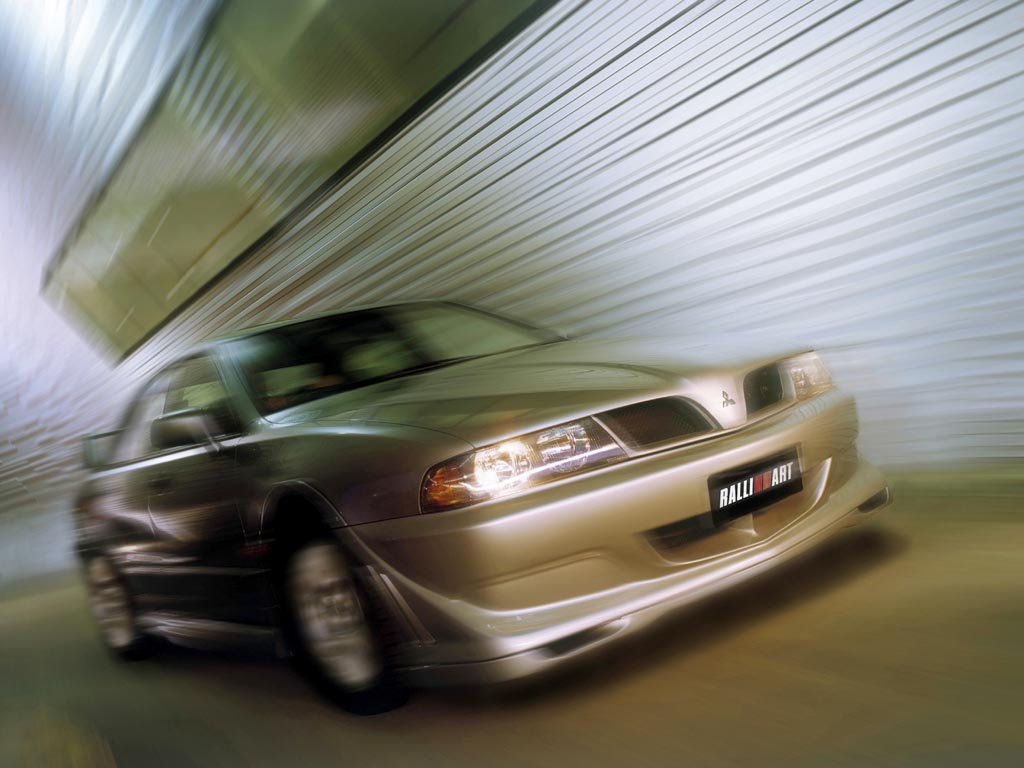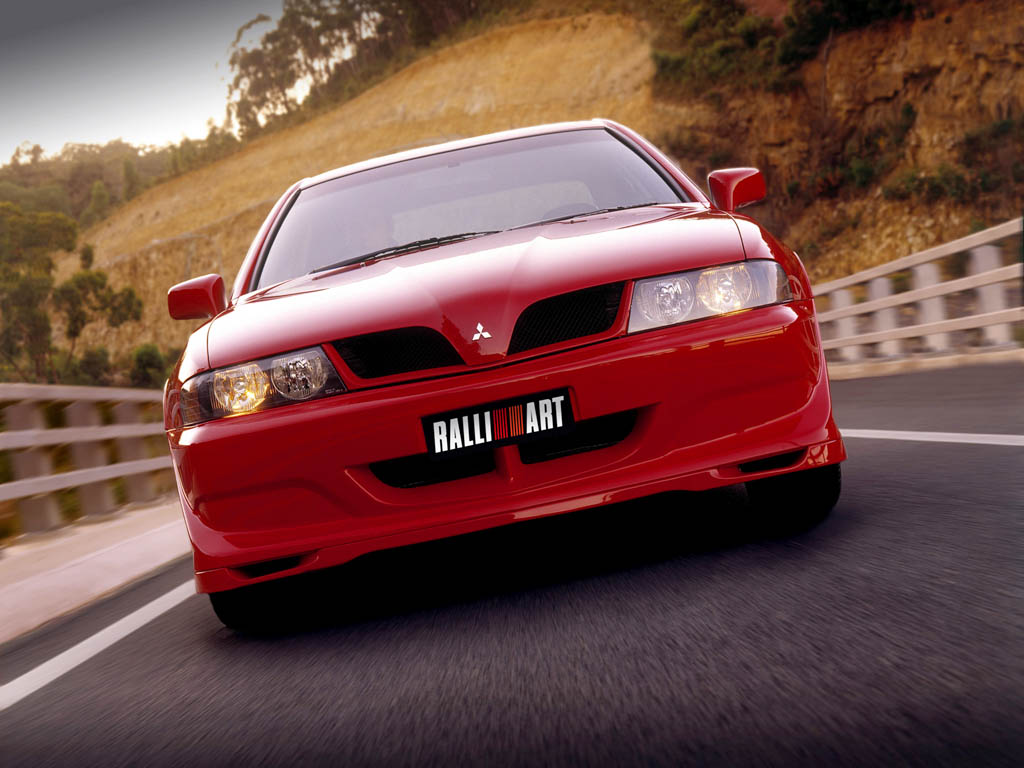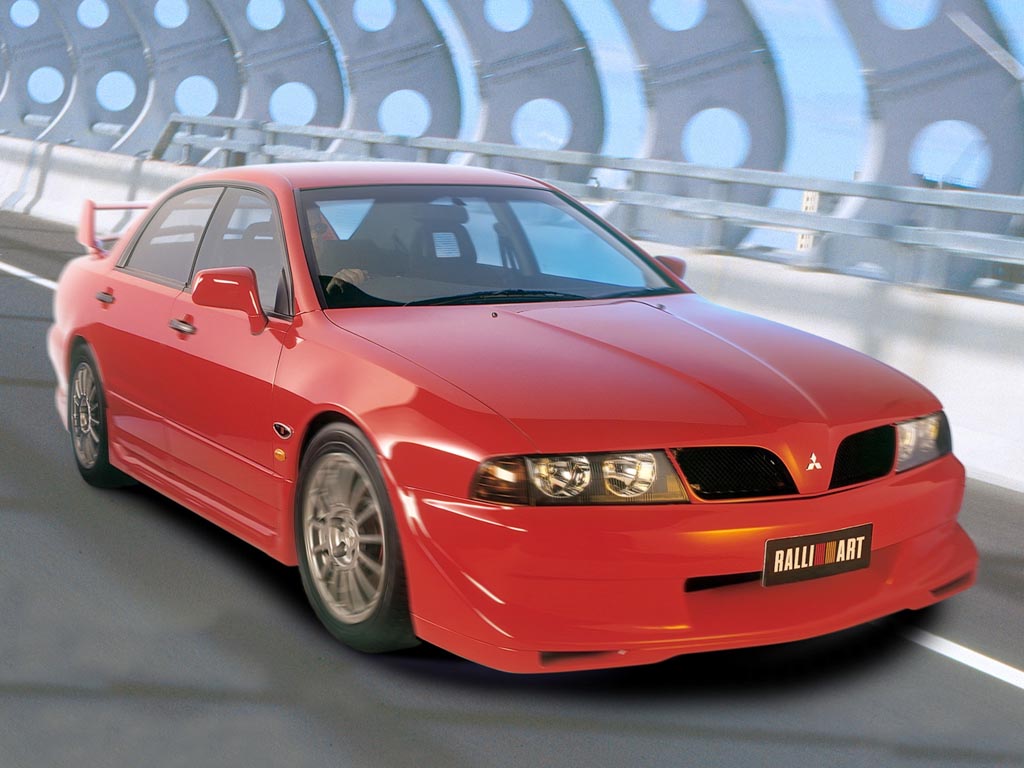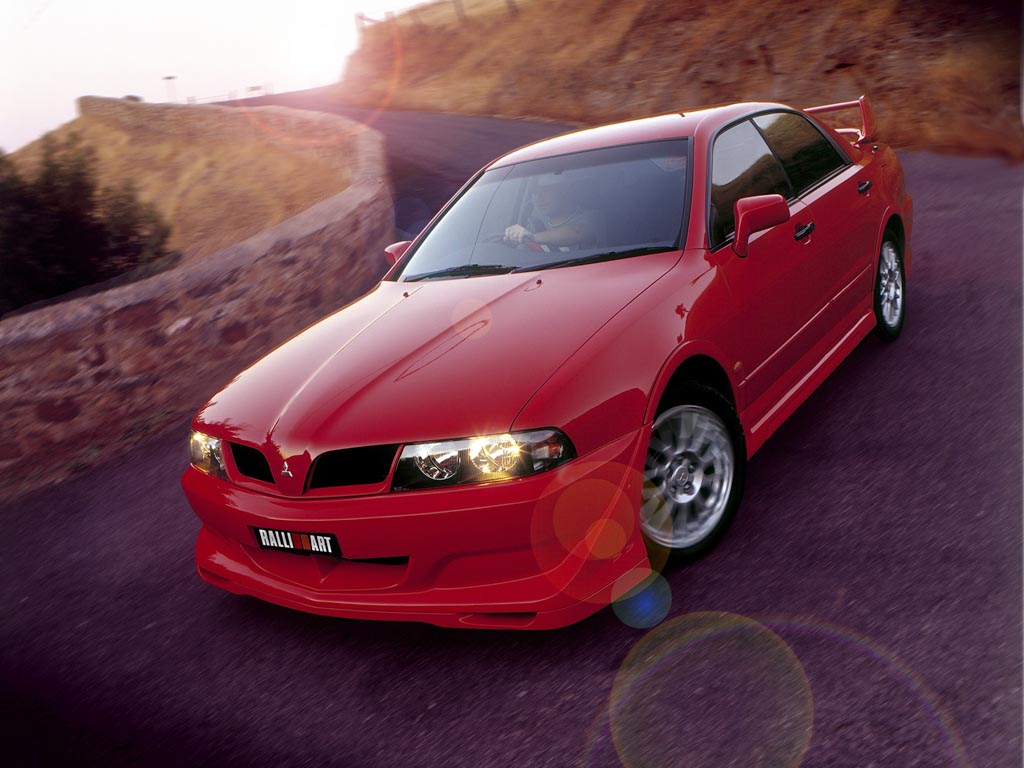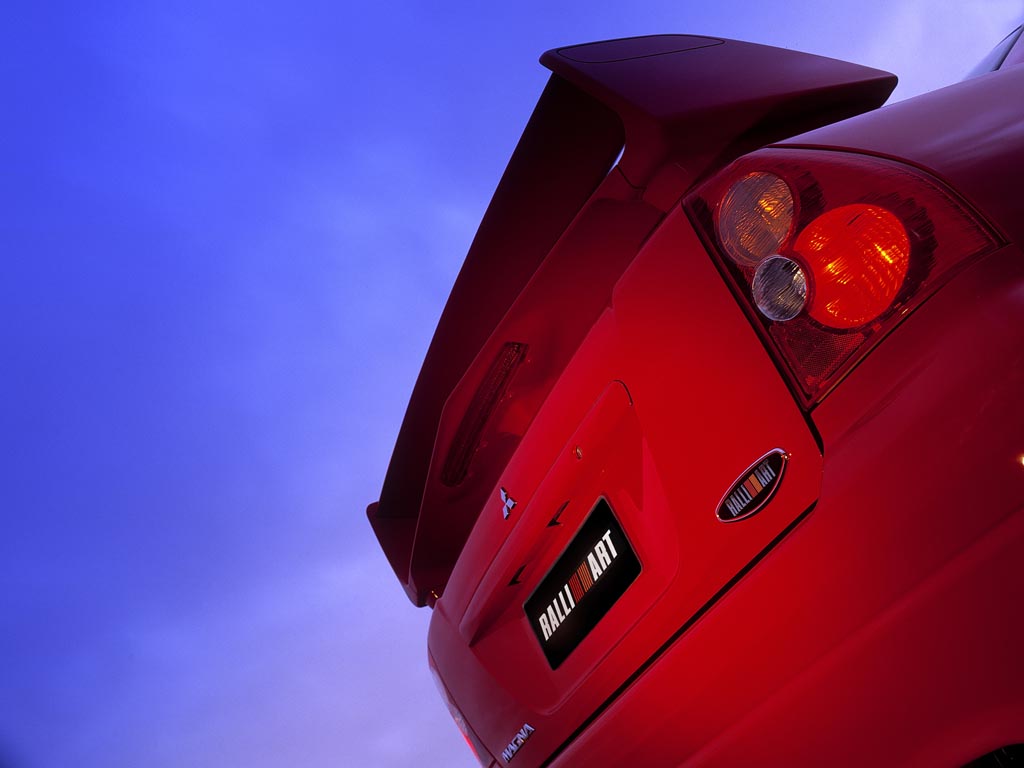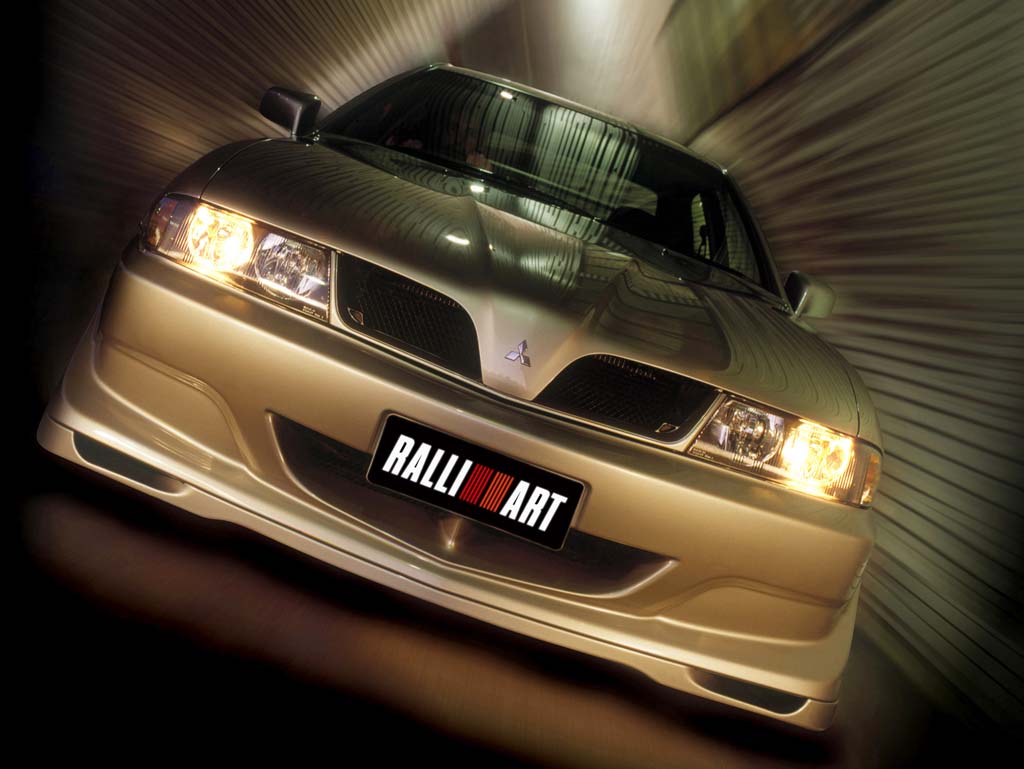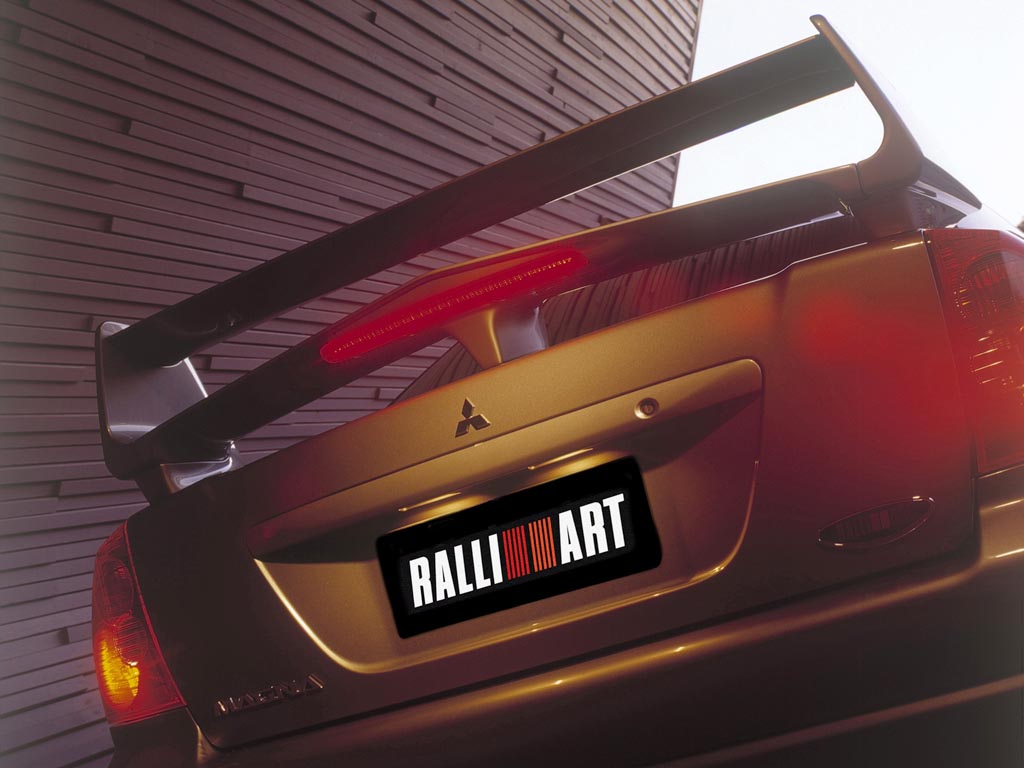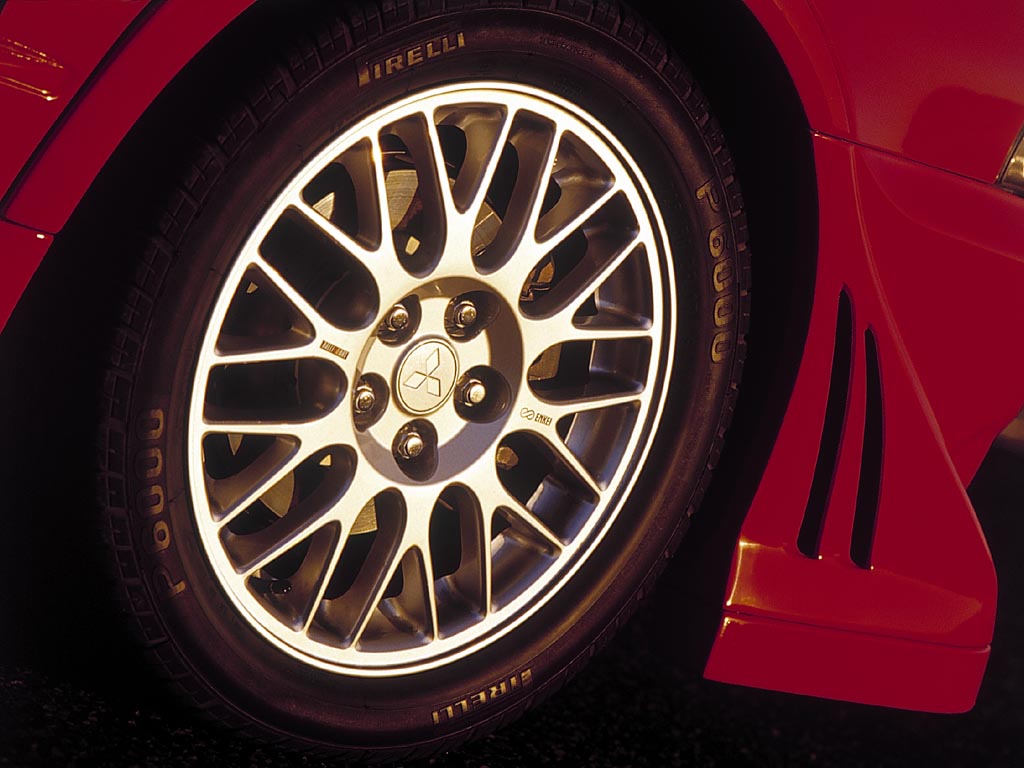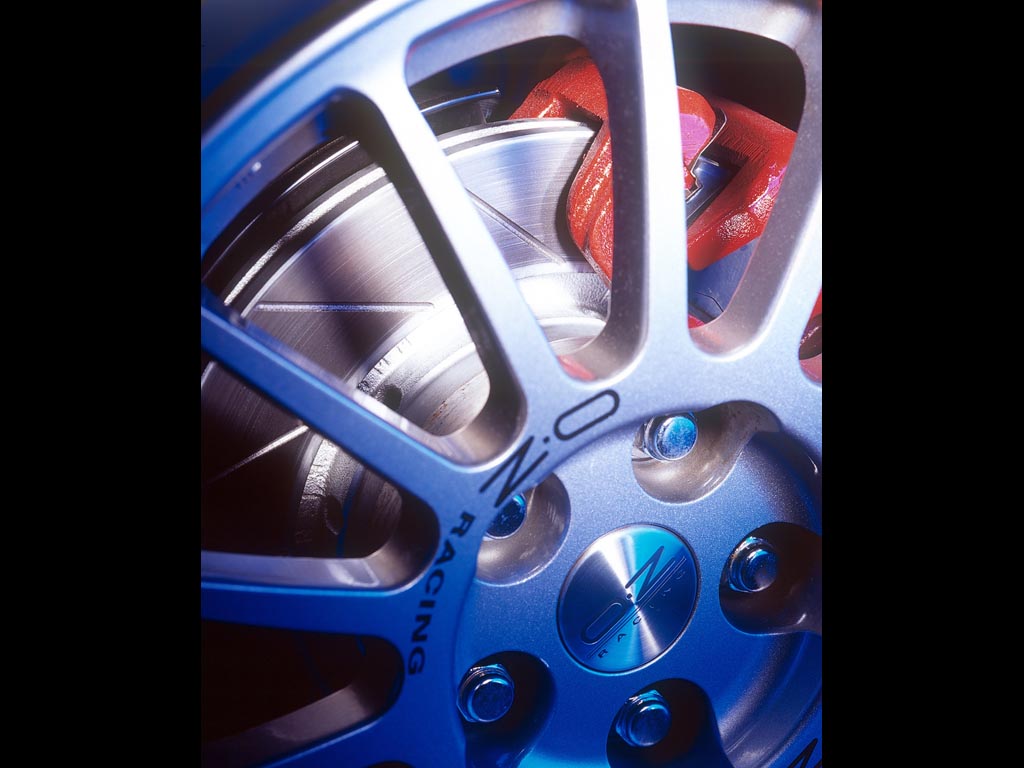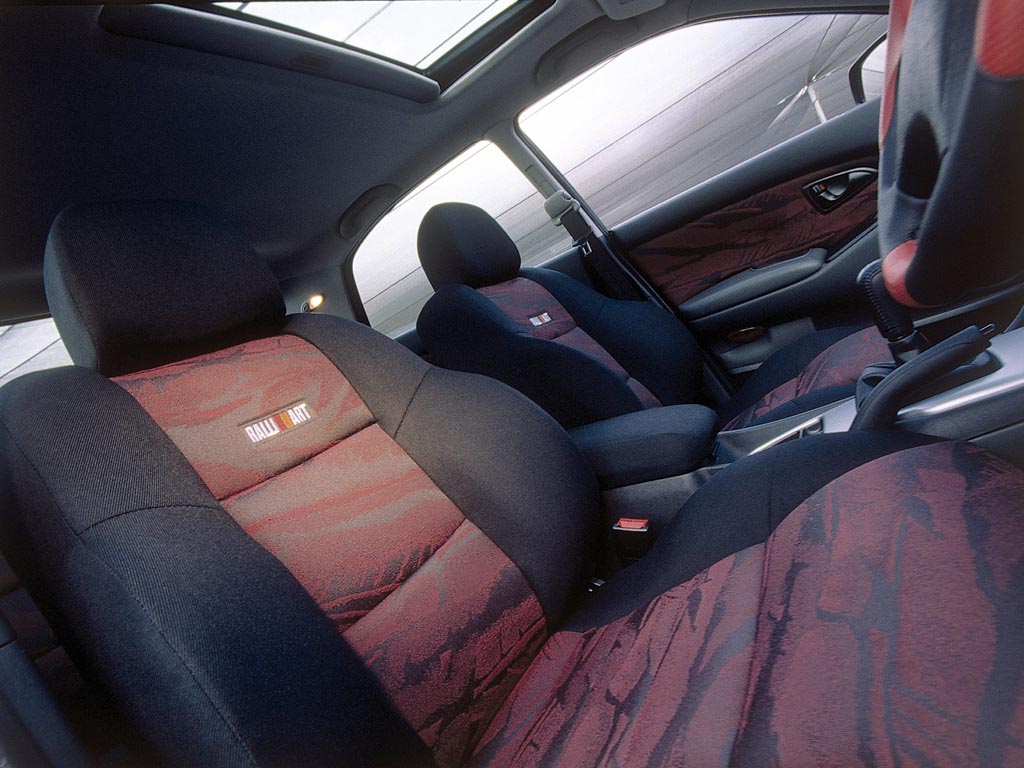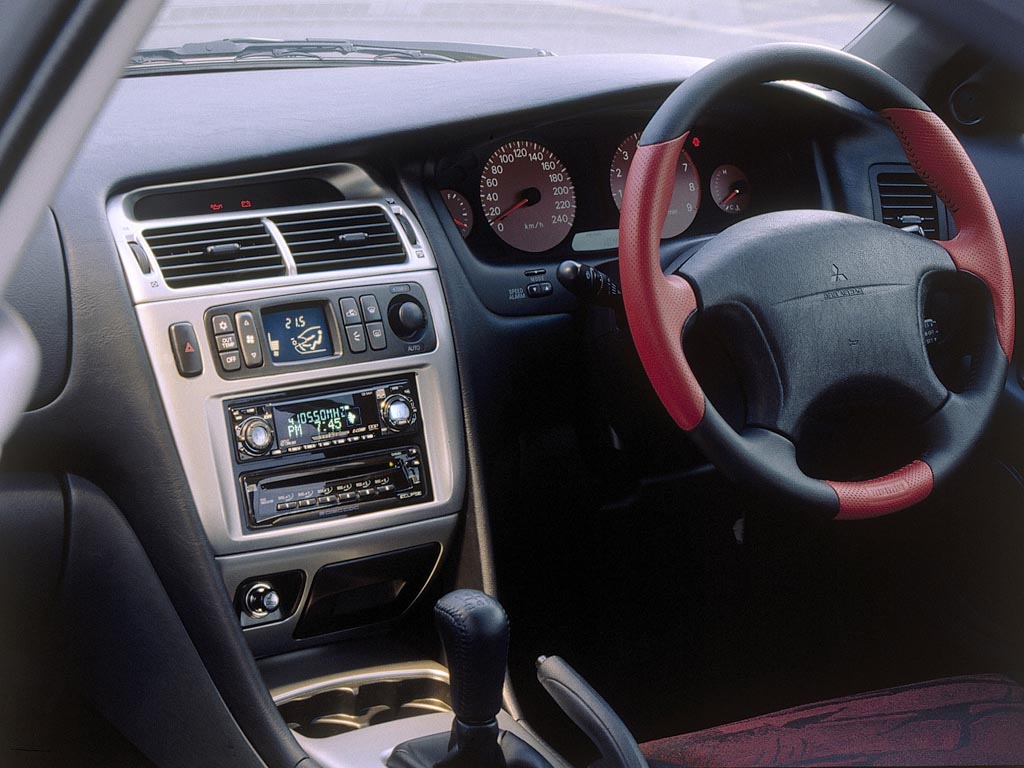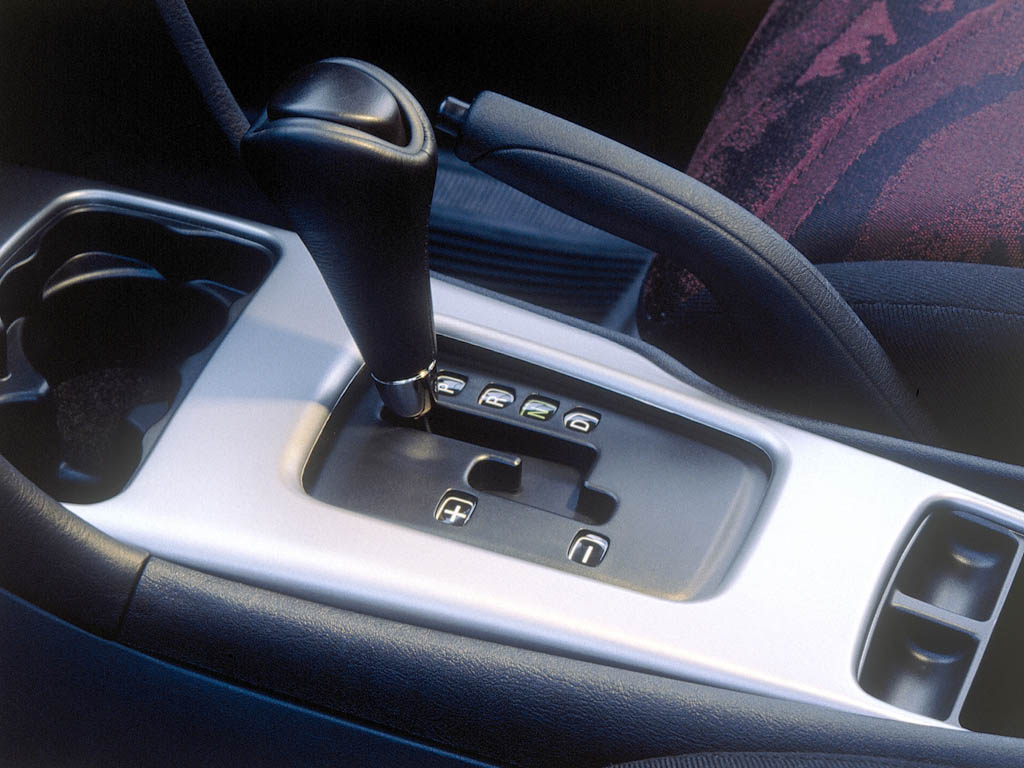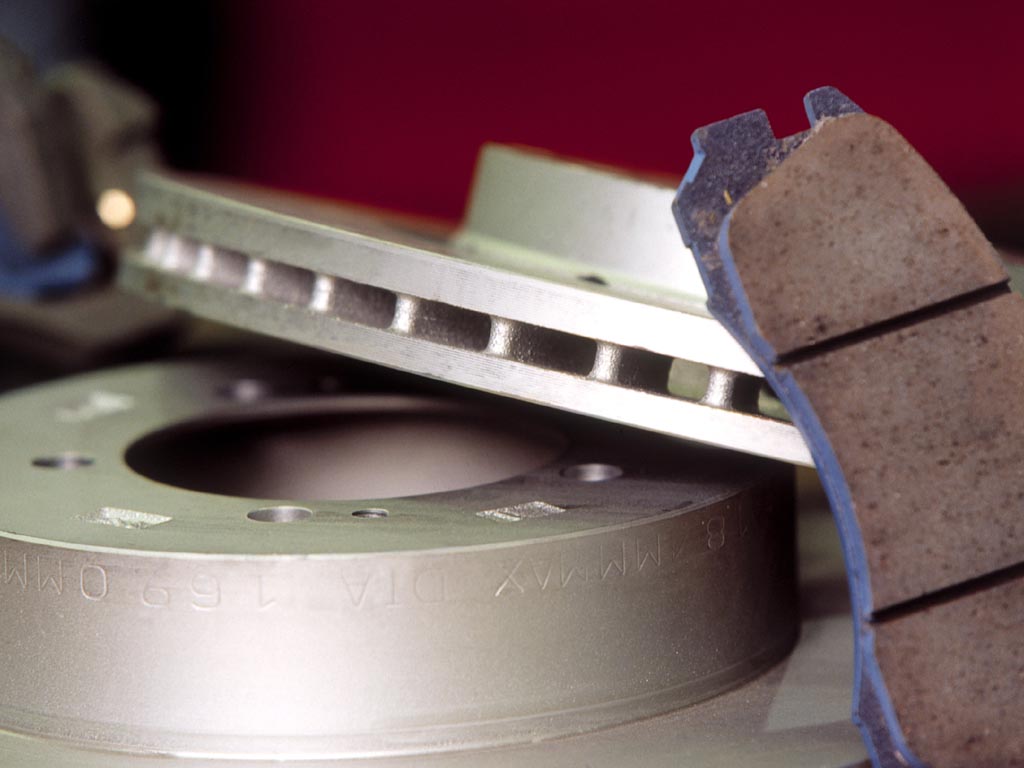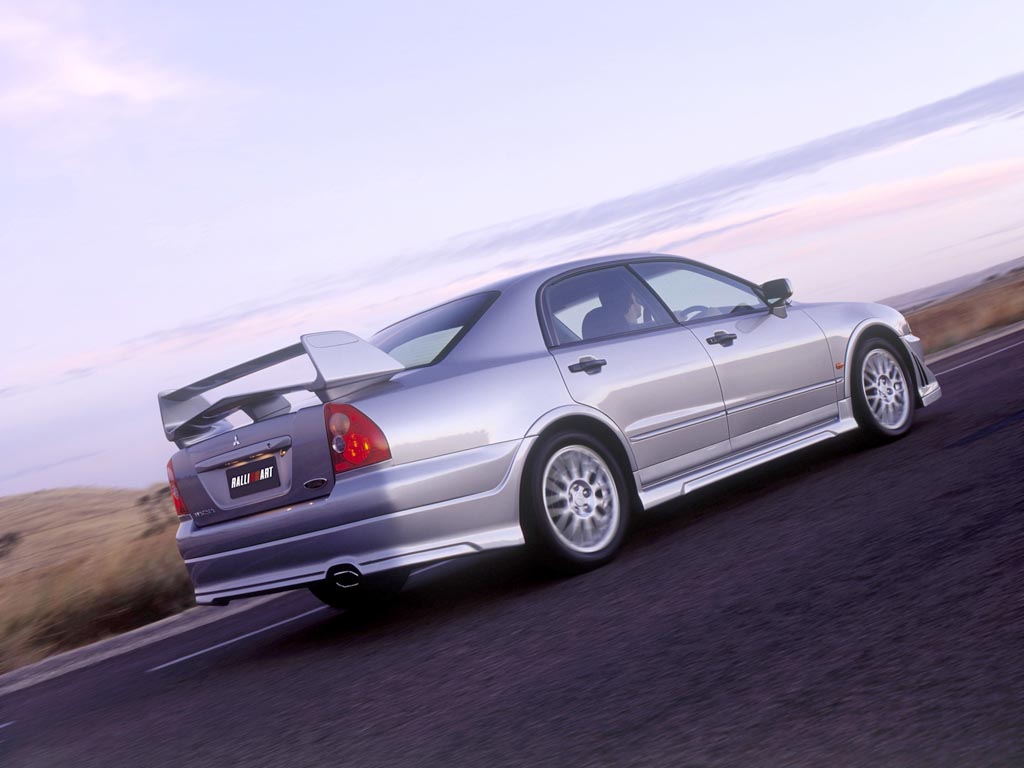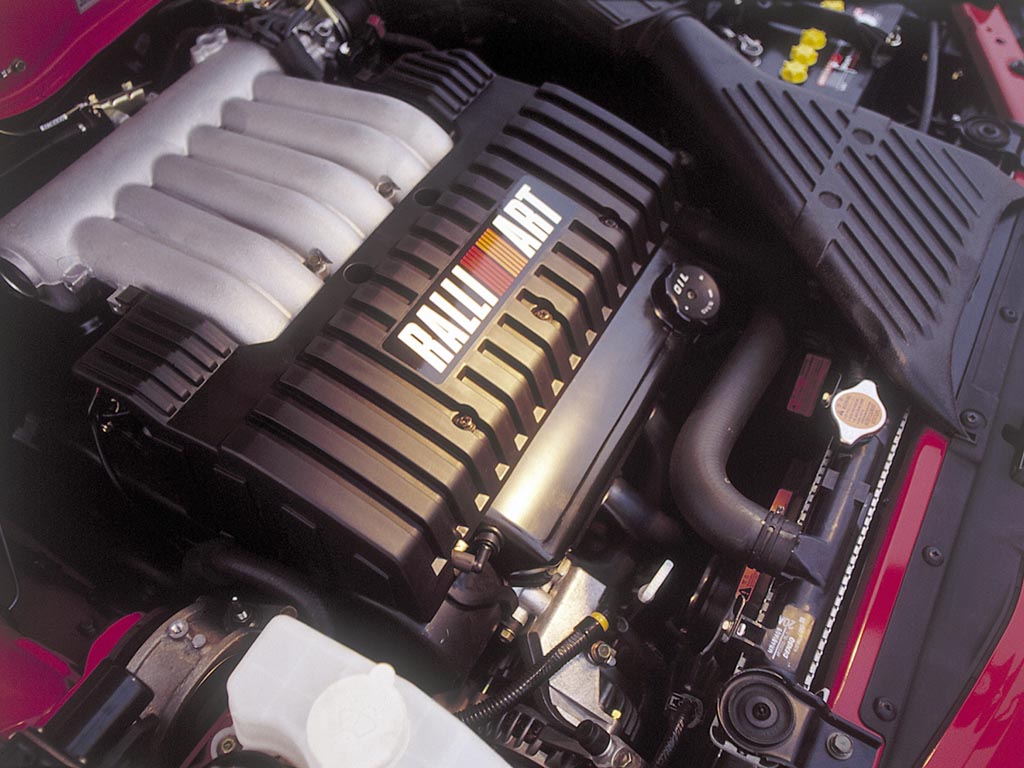2002 Mitsubishi Magna Ralliart
Mitsubishi Motors Australia Ltd. and Ralliart Australia have formed an increasingly closer relationship over the past few years, and the launch of the Ralliart Magna is a clear demonstration of this enduring relationship. Mitsubishi’s hot new performance Magna – with stunning performance and handling gained through collaboration with Ralliart and their extensive motorsport experience – is now in Australia.
The Ralliart Magna has more than a touch of Mitsubishi’s mind-blowing Lancer Evolution VI about it, in both show and go, and is bound to please the enthusiast driver.
Externally, an EVO 6 inspired body kit gives the car a purposeful, aggressive look, particularly as it sits on 17X 7 Enkei alloy wheels shod with 225/50 Pirelli P6000 performance tyres.
However, it is under the skin where most changes have taken place, and they have turned the car into a real goer. The engine has been re-worked with a high-lift camshaft, sports exhaust, new cylinder head, increased compression ratio, stainless steel exhaust headers and revised engine management calibration. The result is a delightfully tractable engine that produces 240hp (180kW) of power and 245 ft.lbs. (333Nm) of torque.
This power is put to the ground with a revised suspension set-up. Springs and dampers have been revised to give more responsive, neutral handling, and were developed in conjunction with performance specialists, Koni. Steering components were also specially calibrated to give the feel and feedback for spirited driving. Consequently, the resulting ride and handling characteristics will be the envy of all mainstream, and many niche sports sedan manufacturers.
Inside, the Ralliart Magna is trimmed with a red, black and silver theme. It has a special Ralliart instrument cluster with red face and white markings, a premium security-coded 14-speaker 188 watt remote controlled Eclipse audio system with 7-CD in-dash facility and the ability to be expanded considerably, uniquely trimmed sports seats for the driver and passenger bearing the Ralliart logo, Momo leather-wrapped steering wheel, as well as silver trim highlights in the centre console.
ENGINE
The engine development started over a year ago as an undercover investigation into the potential gains possible from an improved camshaft with increased compression ratio, and improved flow cylinder heads. The basic Magna 6G74 engine as designed and developed by Mitsubishi Motors Corporation (MMC) is so good, with its racing-style compact 4-valve combustion chambers, central spark plugs and well-shaped ports, that the MMAL engineers knew it must be capable of responding to tuning for higher output. Once the potential gains were determined efforts were undertaken to smooth the design to fit within MMC requirements.
A team, comprising people from Engineering Design, Development Engineering and the Lonsdale Engine Manufacturing Plant, came up with several alternative designs which were subsequently tested during the development phase.
The final iteration has an increased compression ratio (9.4:1 compared with 9.0:1) which was achieved by a reduced piston bowl depth while still maintaining top land height. This ratio was finally settled on, to ensure the car will give optimum performance on ordinary unleaded petrol. Higher ratios could have required the car to run on PULP which was considered undesirable.
An anodised piston crown and top compression ring land were specified to reduce wear and blow-by, while maintaining top end power.
The cylinder head combustion chamber was modified to reduce valve shrouding and improve breathing at small valve openings, thereby making full benefit of the 4-valves per cylinder configuration.
A high lift camshaft profile with 10% additional lift for improved top end performance was fitted. Although other camshafts which produced greater power were tested the deterioration in idle quality and exhaust emissions were considered unacceptable.
Special high lift valve springs, which have a unique cross-section to give increased clearance between coils at the increased lift, and are made from a special nitrided material for improved fatigue strength, are fitted.
The VR-X exhaust system, which was used as the base, was revised with the addition of a large bomb-type muffler to the centre pipe to improve the mid-high rpm exhaust note. After testing three alternative exhaust headers, specially fabricated stainless steel header pipes were added to increase top end power.
The enormous improvement in the top end engine breathing and mid range torque has broken through the limitations of the standard engine. Low speed tractability, a significant boost in mid range torque for acceleration, improved breathing at high rpm for extended high speed driveability, and a reduced need for gear changes under acceleration are all characteristics of this engine.
Manual Transmission
The big news for the manual transmission is the addition of a torque-sensitive limited slip differential (LSD).
As the 3.5 litre engine is one of the largest capacity FWDs, the LSD, combined with the grippy Pirellis, is considered a key factor in harnessing the performance gains achieved and elevating the driving wheels’ adhesion-breaking torque to way beyond that of normal FWD or RWD passenger cars. A Limited Slip Differential was the logical choice for manual variants, while Mitsubishi’s acclaimed Traction and Trace Control system is fitted to automatic variants.
The LSD selected is a torque sensing helical gear differential, as it:
-enables more powerful traction in response to accelerator fluctuations compared to a speed-sensitive viscous coupling type LSD, -gives superior response to accelerator fluctuations compared to regular mechanical LSDs, and -maintains drive even if one wheel experiences significant loss of traction.
The result is torque transfer to the road (even with different left/right wheel grip), even breakaway and the ability to accelerate hard from tight corners. The device gives up to 2.25 times torque difference between the driving wheels.
Handling
Handling
Ralliart has established its enviable reputation in the most gruelling rallies throughout the world by producing great handling cars. And, the Ralliart Magna is no exception, as great attention has been paid to the many facets which all help to provide the final superior handling package.
Magna’s normal standard fully independent suspension, with its McPherson Strut and lower A-arm front, and multi-link with upper and lower control arms and coil spring rear, has generally been regarded as one of the most refined in its class.
Initial testing confirmed that the spring rates could carry over from the latest VR-X iteration. However, Koni struts and shock absorbers were chosen because of their worldwide reputation, and involvement in national and international motorsport. Their premium-quality parts enable precise ride control without the harsh stiction experienced in some less refined performance cars.
Damper tuning was initially carried out at Mitsubishi Motors Australia and then optimised with Toperformance (the local Koni agent), with final fine tuning being conducted at Mitsubishi Motors Australia’s Seymour test facility. Local roads were also incorporated into the program to ensure that the settings chosen gave the optimum balance of ride and handling for a vehicle of this type.
Performance tyres were considered to be an integral part of the total handling package of the Ralliart Magna, and a considerable number of different brands were considered. A select few tyres were shortlisted for evaluation, and Pirelli P6000s were selected. The tyre size is 225/50 ZR17 94W, fitted to EVO 7-style Enkei 17X7JJ alloy wheels.
The speed rating permits up to 270 km/h, but the vehicle is electronically speed-limited to 240 km/h and tyre-placarded as V-rated to allow a wider selection of replacement tyres.
Brakes
Braking performance has improved markedly with the fitting of a 16′ (wheel) braking system used on the Japanese Diamante 4WD, and developed for this vehicle.
Front ventilated disc diameter is increased 18mm over standard (to 294mm), with improved ventilation and thermal distribution to minimise distortion at high temperatures. The front calipers have been upgraded to a twin piston design with 26% increased pad area.
The rear disc is now ventilated and 26mm larger than standard (to 284mm), with a stronger caliper body and 32% increased pad area.
Both discs are cast in a stronger material, and pad materials were selected for improved fade resistance and pedal feel, while retaining very low disc wear. Coupled with the existing load/speed/cornering sensitive Electronic Brakeforce Distribution system (which is controlled by the ABS unit), these improvements give improved braking stability, not only in a straight line but particularly during cornering. This is regardless of passenger or other loading.
Performance
Using the same methods employed by motoring magazines, Mitsubishi claims that Ralliart Magna in either manual or automatic variants – is quicker than either the Falcon XR8 manual or HSV XU6 counterparts. (Source: Motor magazine, August 2001)
| Ralliart Magna m/t | Ralliart Magna a/t | Falcon XR8 m/t | HSV XU6 a/t | |
| 0-100 kph | 6.71 secs | 7.15 secs | 7.36 secs | 7.32 secs |
| 0-400 metres | 14.78 secs | 15.12 secs | 14.96 secs | 15.30 secs |
Top speed is electronically limited to 240 km/h, to allow fitment of V-rated replacement tyres.
Exterior
Exterior
The alloy wheels fitted are newly developed 17X7JJ Enkei alloys, with their styling being very similar to the Lancer Evolution VII wheel. Enkei rims are the wheels of choice of the works rally teams, both nationally and internationally.
The design of the body kit was inspired by the Lancer Evolution VI Tommi Makinen Edition, and gives the Magna an aggressive appearance.
The first fibreglass body parts were secretly tested in the Northern Territory early in 2001, and encompassed stability, cooling effect, brake temperatures and downforce. Further testing was undertaken in the Middle East in mid-2000. The resultant design works effectively to hold the front and rear of the car stable at high speed, enabling effortless high speed cruising and cornering.
The body kit incorporates an aggressively styled front bumper with a large lower grille opening containing a diagonal black mesh insert to complement the upper grille. Fluted ‘gills’ are featured at each side of the front bumper for air management, while a replaceable splitter is also fitted for added street appeal.
Side air dams continue the Evo VI theme, which is also carried through to the extended rear air dam incorporating a large hexagonal shaped chrome exhaust tip.
The rear deck spoiler is a wicker style twin-deck construction, with a fixed upper deck that has been specially angled for optimum balance between downforce and drag.
Interior
Firm sports-style seats are a requirement for a performance vehicle such as the Ralliart Magna. After considering after-market seats as part of the development of the internal theme it was decided for styling and regulatory reasons to develop the seat in house (Mitsubishi Motors Australia is a seat-maker in its own right). In conjunction with Woodbridge Hendersons Automotive Group, the seat pads were developed from a range of seat pad options. The trim lay patterns were then designed, and the seat fully developed through a wide cross-section of evaluators.
The red and black steering wheel is leather wrapped in Italy by MOMO, using MOMO leather.
The instrument cluster features a red background to the dials, with white markings and orange needle. The tachometer bears the Ralliart logo.
Sales
Mitsubishi expects to sell 1,000 of these Ralliart Magnas over the next 12 months, through a specialist sales network of 17 selected dealers.
Story by Mitsubishi Motors Australia Ltd., Edited by Supercars.net
In Detail
| submitted by | Richard Owen |
| price $ | $ $48,990 AUD |
| engine | V6 |
| position | Front Transverse |
| aspiration | Natural |
| valvetrain | 4-Valves per Cyl |
| fuel feed | Electronic Multi-Point Fuel Injection |
| displacement | 3497 cc / 213.4 in³ |
| bore | 93 mm / 3.66 in |
| stroke | 85.8 mm / 3.38 in |
| compression | 9.4:1 |
| power | 180 kw / 241.4 bhp @ 5500 rpm |
| specific output | 69.03 bhp per litre |
| torque | 333 nm / 245.6 ft lbs @ 4000 rpm |
| driven wheels | FWD w/Torque Sensing Helical Gear Limited Slip Differential |
| front tires | 225/50 ZR 94W Pirelli P6000 |
| rear tires | 225/50 ZR 94W Pirelli P6000 |
| front brakes | Ventilated Discs w/Twin-Pot Calipers, ABS, EBD |
| f brake size | x 294 mm / x 11.6 in |
| rear brakes | Ventilated Discs w/Single-Pot Calipers, ABS, EBD |
| r brake size | x 284 mm / x 11.2 in |
| front wheels | F 43.2 x 17.8 cm / 17 x 7 in |
| rear wheels | R 43.2 x 17.8 cm / 17 x 7 in |
| steering | Rack & Pinion w/Power Assist |
| f suspension | McPherson Struts w/Lower A-Arm, Koni Damping and Spring Unit, 22mm Anti-Roll Bar |
| r suspension | Multi-Link w/Upper and Lower Control Arms, Coil Springs, Koni Telescopic Shock Absorbers, 18mm Anti-Roll Bar |
| wheelbase | 2722 mm / 107.2 in |
| front track | 1545 mm / 60.8 in |
| rear track | 1535 mm / 60.4 in |
| length | 4820 mm / 189.8 in |
| width | 1809 mm / 71.2 in |
| height | 1435 mm / 56.5 in |
| transmission | 5-speed Manual |
| gear ratios | 3.333:1, 2.015:1, 1.407:1, 1.031:1, 0.804:1, :1 |
| final drive | 3.736:1 |
| 0 – 60 mph | ~6.6 seconds |


